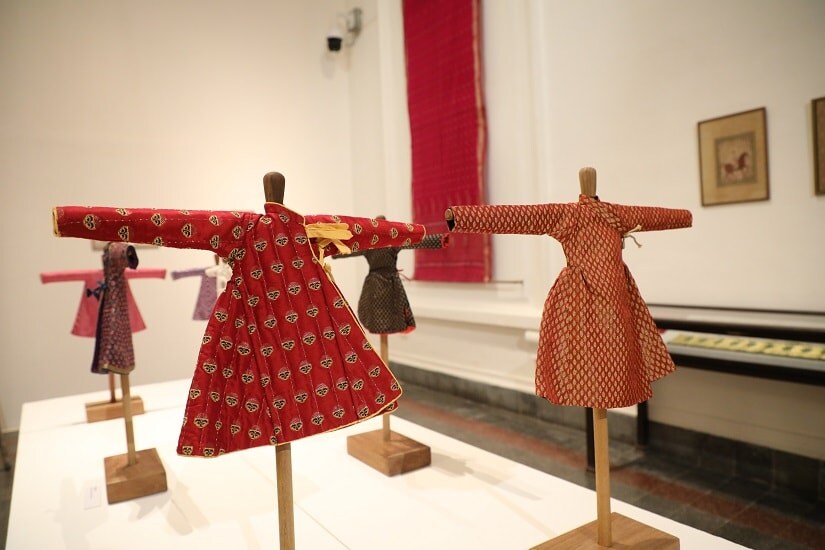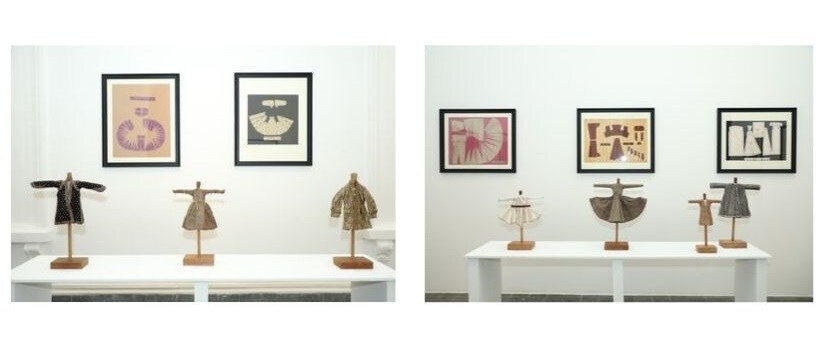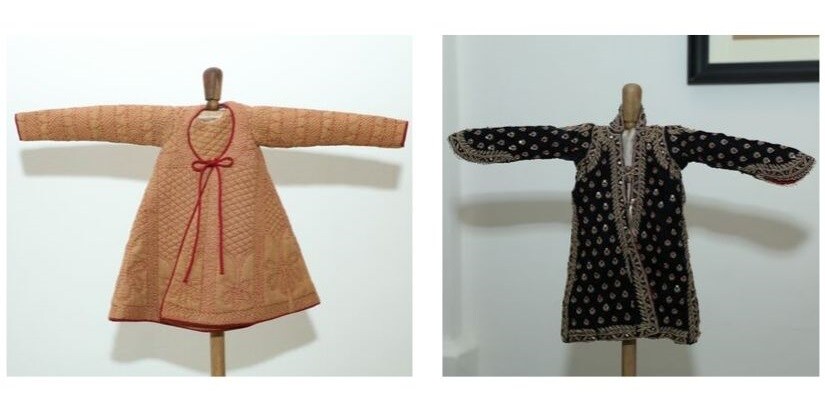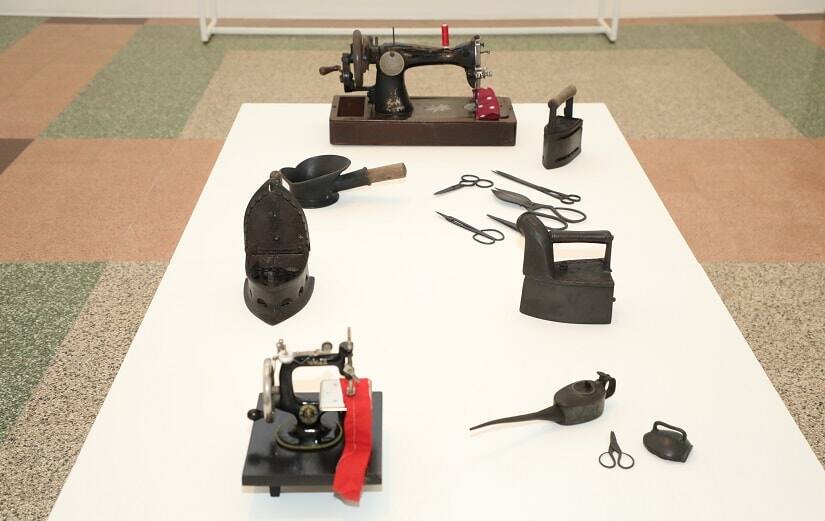Up until the early 1950s, the word ‘maharaja’ would invariably conjure a flurry of images — a towering figure lording over his loyal subjects, owning an unfathomable amount of wealth and property, and intricately bejewelled couture. While officially recognised royalty is a thing of the past, several successors of such bygone ‘maharajas’ choose to hold on to the moniker as a souvenir. As a result, besides their dwindling socio-political prowess, the erstwhile rulers of the land have also had to simmer down their display of opulence. Their current aesthetic tastes swing more towards the contemporary than the decadent, if one might add. Artist Geeta Khandelwal’s latest exhibition aims to revisit this long-lost regal grandeur and extravagance, by drawing on fabrics, patterns and styles that span over a hundred years, — from 1850 to 1950 — through recreating costumes of the maharajas as miniatures. [caption id=“attachment_7465801” align=“alignnone” width=“825”]  Installation view of quilted jamas[/caption] “Costumes, as per the Oxford dictionary means ‘a set of clothes in a style typical of a particular country or historical period,’” she says, quickly adding the bit on how it differs from garments, (defined as ‘a piece of clothing’) which are often used as interchangeable terms. “So, there’s a lot of history, research that goes into making a costume,” the artist adds. An avid collector of beautiful and exquisite fabrics, Khandelwal, who’s in her 80s, has been working in the field of textile artistry for over five decades now. The idea struck her after she saw a miniature costume of an Indonesian king during one of her trips. The image stayed with her for years, leading her to her “voyage of discovery”. “These miniatures can tell a story of the past in a small space. They transport you to a magical world. They can be visualised as fantasy, almost like from the viewpoint of a child,” she says. In order to give shape to her desire of putting up this miniature exhibition, Khandelwal relied on Calico Museum’s (Ahmedabad) 1993 publication, Indian Costumes in the Collection of the Calico Museum of Textiles by BN Goswamy and Kalyan Krishna. “I only referred to the Calico book as a reference guide because the patterns of the choghas, angarkhas and jamas are drawn to scale at the back of the book. Besides, the actual costumes are in the collection of the Calico Museum in Ahmedabad.” Khandelwal has chosen to reproduce only men’s clothing — upper garments to be precise — for this exhibition, in order to showcase diverse patterns, styles, and weaves that go into making each costume. “India is a vast country. Each geographical area has its own costume, suiting the local climate and availability of fabric,” she says. Khandelwal further elucidates by citing the examples of how people living in the north — like Kashmir, Punjab, and the foot of the Himalayas — don woollen and quilted fabrics to brave the chilly weather, while people in the south turn to cotton fabrics for surviving warmer temperatures. “In Rajasthan, people wore angarkhas of printed or tie-and-dye cloth. Cotton angarkhas were worn for daily wear, but for weddings or festivals costly materials like brocade, silk and velvet were used by the royal families,” she adds. [caption id=“attachment_7465811” align=“alignnone” width=“825”]  (Left) Installation view of chogha, angarkha and sherwani with cut patterns. (Right) Installation view of Gaddi’s coat, jama and chogha.[/caption] [caption id=“attachment_7465821” align=“alignnone” width=“825”]  (Left) Quilted angarkha, was worn during winters in north India. (Right) Detail of chogha: black velvet and hand-embroidered with gold threads, sequins and French knots.[/caption] In the 19th century, stitched upper garments for male royalty meant a loose upper coat with a fitted bodice and a flared skirt. Besides that, the headdress or turban made from a piece of long unstitched fabric was a distinguishing factor too, Khandelwal points out. She also gives a rather interesting insight into the history of stitched garments in the Indian subcontinent. “When it comes to textiles, there is no other place like India that weaves in as many ways or dyes or block prints to prepare a cloth,” she says. “But the art of sewing was not known to Indians. They wore unstitched garments — straight out of the loom — like the five-yard saree for women, the lungi for men and a turban or a dupatta or an odhni. Stitched garments were considered impure, therefore no stitched garments were worn during a puja or at the time of offering prayers.” It is only with the invasion of foreigners, such as the Mughals and the British, that stitched clothing came into fashion, and was simultaneously adopted by the royals and the masses. “So, while Indian textiles clothed the world around, stitched clothing in India was an import for the longest time.” For the exhibition, Khandelwal has tried to weave in as many fabrics as possible, in order to uphold diverse textiles and styles. She has used rich brocades from Varanasi, tiny block prints from Jaipur, fine muslins and jamdanis from Dhaka, intricate chikankari from Lucknow, pashmina, jamawar hand embroideries from Kashmir, and khaadi, velvet, mushru and hand-woven cotton from Kutch. Despite her prolific knowledge in the domain, staging an exhibition on classic miniature costumes was an uphill task. “Nobody else had made miniatures to scale, before this. I had very little reference and hence I had to train myself to make the impossible possible, with dedication,” the artist says. While each miniature costume has been hand-stitched by her, she also collaborated with master tailors and embroiderers, shelling out large sums of money in order to get the perfect design. Talking about the entire process of creating a miniature costume, Khandelwal explains how she had to make an accurate paper pattern of the garment, following which it had to be blown up to a size of nine inches to scale. She emphasises on the importance of choosing the right fabric, which also happens to be the second step in costume-making. A lot of the fabrics used in the exhibition have come from her personal vintage collection. “I am a collector — I pick up anything I feel looks and feels ancient, and then leave it in my cupboard for 10 years, or sometimes even 30 years, and then forget it,” she says. After finding the right material, she makes it a point to inspect it in a variety of natural lights: the morning light, daylight, and evening light. Thereby, it ceases to remain a mere piece of clothing, and transforms into a work of art.
“I work as an artist, not as a seamstress,” she remarks.
Geeta Khandelwal had to then find matching lining and piping material to go with the main fabric. “I drew the patterns on the lining, hand-stitched the lining and the main fabric separately before attaching the two together, and then added the gussets, sleeves and collar using my little finger to accurately position them,” she explains. “They have been stitched with utmost care.” In doing all this, the artist has ensured high quality in both look and feel. “I have been very particular about inner linings, seams, and detailing of the armhole and collars, which are the most difficult parts of the process. We have avoided using polyester, but (have used) only 100 percent cotton or silk, jacquard or brocade,” she informs. [caption id=“attachment_7465831” align=“alignnone” width=“825”]  Installation view of vintage irons, scissors and sewing machines[/caption] Despite having a rich textile heritage, India has very few to no surviving specimens of these ornate and intricate costumes in their entirety. Khandelwal cites two reasons for this: first, the intense weather conditions in India. High moisture levels are not good for preservation. Neither is extreme heat or sunshine. Secondly, India does not really have a tradition of preservation and documentation. Over the years, techniques and disciplines have been passed on orally. “Preserving textiles needs a special knowledge of repairing, documenting and photographing them; it needs proper air conditioning. All of this takes a lot of funding,” Khandelwal points out. For her, this exhibition is a means to “inspire and educate the future generation” about India’s historical garments. “I hope this helps them to learn the complexity of design techniques, and at the same time, open them to their own creativity.” — All images courtesy of Dr Bhau Daji Lad Museum ‘Classic Miniature Costumes’ exhibition will be on view at the Kamalnayan Bajaj Special Exhibition Gallery in Dr Bhau Daji Lad Museum from 2 October to 28 October, 2019.


)
)
)
)
)
)
)
)
)



